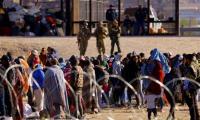Punjab is and will be the centre of politics in the next three months as the Election Commission of Pakistan (ECP) is about to announce the election schedule for Punjab and Khyber Pakhtunkhwa Assemblies, which were dissolved last week.
The outcome of these polls would set the tone for the forthcoming general elections of the National Assembly and the two other provincial assemblies - Sindh and Balochistan - whether they are held as per schedule in October, this year or earlier.
Even before the polls, a controversy had already hit Punjab over the nomination of the caretaker chief minister by the ECP after the government and the opposition in Punjab failed to evolve a consensus on the name of the caretaker CM.
The ECP named head of a media house and journalist-cum-owner, Mohsin Naqvi amid protest from PTI as his name was recommended by the PDM. Unlike in KP, where the issue was amicably resolved, the politics in Punjab may drag this issue to the court as well. “We will not accept him and ECP has confirmed its bias towards PDM and against PTI,” said party leaders.
The dilemma of the ECP has been its limitation as the electoral watchdog has to pick one out of the four nominees recommended by government and opposition. It is time they should bring an amendment and empower the ECP to name his own nominee in case both sides failed to recommend any one name.
Pakistan Tehreek-e-Insaf (PTI) has been ruling KP since 2013 and if the party retains its position, it would break its own record for the third consecutive term. In 2018, PTI made a record by not only winning for the second time but also achieving from simple to two-third majority. So, it will be quite a challenge for PTI to maintain its position. It will also be quite a challenge for parties like Awami National Party, ANP, Jamiat Ulema-e-Islam, JUI (F), Pakistan Muslim League, PML (Nawaz) and Pakistan Peoples’ Party, PPP to defeat PTI, even if they also join hands. The nationalist party like Pashtun Tahfooz Movement (PTM) could also be the surprise package for all the parties, provided they get the level playing field.
It will also for the first time the former FATA after its merger with KP would also get a chance to elect their representatives for KP Assembly. Now, which way it can go, would be difficult to say but in an overall political scenario, PTI still has a slight edge over its rivals. One alarming factor could come from the alleged terror network in the wake of attacks from Tehreek-e-Taliban Pakistan (TTP). If it hits KP elections, the outcome could be the repeat of 2013 elections when ANP and PPP became its prime target.
However, one must laud the way KP politicians from both government and opposition had resolved the issue pertaining to the nomination of the caretaker chief minister amicably unlike in Punjab. Similarly, the governor KP signed the summary of the dissolution of KP Assembly as soon as he received the same from the CM. In Punjab, the governor did not sign it and as a result, Punjab Assembly was dissolved within 48-hour as per the Constitution. This in itself showed the difference of approach in the two provinces as well as rising political tensions between the two key players, PTI and PMLN.
Therefore, it is the battle for Punjab or in other words battle for ‘Takhat-e-Lahore,’ which matters most and in all probability would also decide the future landscape of Pakistani politics as who will rule the country in the next five years, provided the future government completes its term in office.
Interestingly, both the key parties PMLN and PTI have their own internal issues which are also reflected in the post 2018 elections and they may face far more daunting challenges even at the present as they are gearing up for the elections.
In 2018, the PMLN had emerged as the single largest party in Punjab but could not form the government as the PTI with the support of Pakistan Muslim League Quied-e-Azam (PMLQ), Janoobi Punjab Mahaz (JPM) and independents formed the coalition government. They are also said to be backed by the then powerful establishment. But, the differences within the PTI emerged when one of its senior members namely Shah Mahmood Qureshi lost the provincial assembly seat but won the National Assembly seat. He publicly blamed the then senior leader of the party Jehangir Khan Tareen for playing a role in the defeat. Tareen was Imran’s first choice for the CM but unfortunately he was disqualified by the Supreme Court. Earlier in 2013, prior to general elections, very sharp internal differences had also emerged in the party elections between the two beside some other PTI groups as well.
PMLN, one the other hand despite the setback in 2016, when its leader and former prime minister Nawaz Sharif was disqualified, did not perform badly in the 2018 elections and emerged as the single largest party in the Punjab Assembly. PTI never felt comfortable despite being in the government due to which they not only avoided holding local bodies’ elections in Punjab but in 2020 dissolved all the elected bodies and appointed ‘administrators.’ The PMLN also won a majority of the by-elections during 2020 to 2021.
In the post April 10, 2022, political scenario - since the vote of no confidence against the former prime minister Imran Khan - the PDM in general and PMLN in particular faced back-to-back defeat. They twice attempted to dislodge PTI backed PMLQ chief minister Ch. Pervez Elahi but failed. They also lost most of the by-elections.
All this caused serious concern within PMLN and for the first time, its internal differences have come to surface amid former PM Nawaz Sharif’s continued absence from Pakistan since 2021. While there are still ‘ifs and buts’ over Sharif’s return, he decided to send his daughter Maryam Nawaz after appointing her as senior vice president and chief organizer of the party amid dissenting voices within the party. Some are silent, some are now vocal over the way party affairs are being run.
Can PMLN go in the election campaign and polls in April with such a ‘divided house’ depending on how the Sharif family resolved their own differences and how they were able to satisfy senior party leadership.
All is now well in the PTI as well. Interesting scenario may emerge within the party if the PMLQ accepts Imran Khan’s offer and merges its faction or Ch. Pervez Elahi and his son Monis Elahi join PTI then IK appoints Pervez Elahi as president of the party and gives important position to Monis as well.
It may not go well in some of the PTI leaders from Punjab like Shah Mahmood Qureshi or even some other candidates for the next CM.
Imran and Ch. Pervez Elahi had a history of ‘love and hate’ since 2007, but now they have come close to each other and Khan had lauded both Elahi and Monis for siding with him during the crisis.
One thing is certain whoever wins the battle of Punjab and KP, will have an upper hand in the next general elections in the country. It will also be interesting to watch who will get the top slot in both the provinces. Will Imran retain Mahmood Khan and Ch. Pervez Elahi, if PTI wins? Who will be CM Punjab, if PMLN win would also be quite a choice for Sharifs. In KP, it could be a joint candidate of PDM, if they manage and secure a majority.
The writer is columnist and analyst of GEO, The News and Jang
Twitter@MazharAbbasGEO
Produced by Abdullah Kadwani and Asad Qureshi, “Behkaway” will air daily at 9 PM on Geo TV
Usman Riaz Gul and Zaheer Abbas appeared in the court on behalf of the PTI founder
The first drive held on February 15 examined 72,277 people free of charge on a nationwide basis
Deceased were identified as Senior Civil Judge Mardan, Hayatullah, son of Pir Gul, resident of Kalam
Sources say govt did not give proper response to points and reservations raised by PPP in the meeting
Deceased has been identified as Shah Bakhsh







